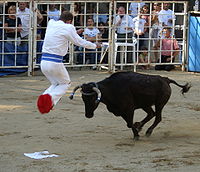Bull-leaping


Bull-leaping (
Iconography

Younger (1995) classifies bull-leaping depictions in Bronze Age Aegean art as follows:
- Type I: the acrobat approaches the bull from the front, grabs the horns, and somersaults backwards
- Type II: the acrobat approaches the bull from the front, dives over the horns without touching them and pushes himself with his hands from the bull's back into a backward somersault
- Type III: the acrobat is depicted in mid-air over the bull's back, facing the same way as the animal
The Type III depictions are often found in
Other examples of bull-leaping scenes have been found in
Minoan Crete

Bull-leaping is thought to have been a key ritual in the religion of the
The assumption, widely debated by scholars, is that the iconography represents a ritual sport and/or performance in which human athletes—both male and female[5]—literally vaulted over bulls as part of a ceremonial rite. This ritual is hypothesized to have consisted of an acrobatic leap over a bull, such that when the leaper grasped the bull's horns, the bull would violently jerk its neck upwards, giving the leaper the momentum necessary to perform somersaults and other acrobatic tricks or stunts.[citation needed]
Barbara Olsen, associate professor of Greek and Roman Studies at Vassar College, adds that the sport was probably not especially dangerous for participants. "From the images it looks like they [leaped over the bulls] successfully—the Minoans tend not to give us too much violent imagery, so the bull-leaping usually ends pretty well,"[5] but the goring scene on the "boxer's rhyton" found in Hagia Triada suggests that injuries were not unknown.
Contemporary bull-leaping



Bull-leaping is still practiced in southwestern France, where it is traditionally known as the course landaise, although usually aggressive cows are used instead of bulls. They are the female stock of the fighting bulls bred for the corrida in Spain. However, once per year bulls are used, in the Festival of Art and Courage. The town of Mont-de-Marsan in Gascony is renowned for its fine sauteurs or 'leapers' and écarteurs ('dodgers') dressed in brocaded waistcoats. They compete in teams, attempting to use their repertoire evasions and acrobatic leaps to avoid the cow's charges.
The cow is typically guided by the use of a long rope attached to its horns, so that it runs directly at the performers and is restrained from trampling or goring them should they miss a trick. Although there is little to no risk to the cow in this form of contest, it is a highly dangerous sport for the human participants; a prominent competitor from Montois, Jean-Pierre Rachou, was killed in 2001 when he fell on his head after being hit by a cow.
The courses landaises are held from March to October on the occasion of festivals in many cities and villages, including Nogaro, Mont-de-Marsan, Dax, Castelnau-d'Auzan, and many other places. There are also national championships.
Bull-leaping is also practised in
Jallikattu is typically practised in the Indian state of Tamil Nadu as a part of Pongal celebrations on Mattu Pongal day, which occurs annually in January.
As there were incidents of injury and death associated with the sport, both to the participants and to the animals forced into it, animal rights organizations have called for a ban to the sport, resulting in the court banning it several times over the past years. However, with protest from the people against the ban, a new ordinance was made in 2017 to continue the sport.
A similar but even more dangerous tradition of non-violent bull-leaping,
See also
References
- CIG 3212) and at Sinope(CIG 4157).
- ^ One argument for the association of Minoan Crete with the Bronze Age culture of the Indus Valley by H. Mode (Indische Frühkulturen und ihre Beziehungen zum Westen, Basel, 1944); since the 1940s, further bull-leaping motives have been discovered in 2nd millennium BC contexts in Bactria and northern Anatolia.
- ^ Rohl, David, The Lords of Avaris, Random House, 2007.
- ^ Hogan, C. Michael (2007). "Knossos: Fieldnotes". The Modern Antiquarian.
- ^ a b Kolitz, Daniel (January 6, 2020). "What Was the Most Fun Thing Humans Could Do 5,000 Years Ago?". Gizmodo.
Bibliography
- Collon, D.; "Bull-Leaping in Syria"; International Journal for Egyptian Archaeology and Related Disciplines 4 (1994); pp. 81–88.
- McInerney, J.; "Bulls and Bull-leaping in the Minoan World"; Expedition Magazine 53:3 (December 2011).
- Marinatos, Nanno; "The Export Significance of Minoan Bull-leaping Scenes"; International Journal for Egyptian Archaeology and Related Disciplines 4 (1994); pp. 89–93.
- Marinatos, Nannó; "Minoan Religion: Ritual, Image, and Symbol"; Studies in Comparative Religion; Columbia, South Carolina: University of South Carolina Press, 1993.
- Shaw, Maria C.; "The bull-leaping fresco from below the Ramp House at Mycenae: a study in iconography and artistic transmission"; The Annual of the British School at Athens 91 (1996); pp. 167–190
- Sipahi, Tunç; "New Evidence From Anatolia Regarding Bull Leaping Scenes in the Art of the Aegean and the Near East"; Anatolica 27 (2001); pp. 107–125.
- Younger, J.; "Bronze Age Representations of Aegean Bull-Games, III"; Aegaeum 12 (1995); pp. 507–46, PDF.
External links
- Brennan, Marie (2005); "Bull-Leaping in Bronze Age Crete"; Strange Horizons
